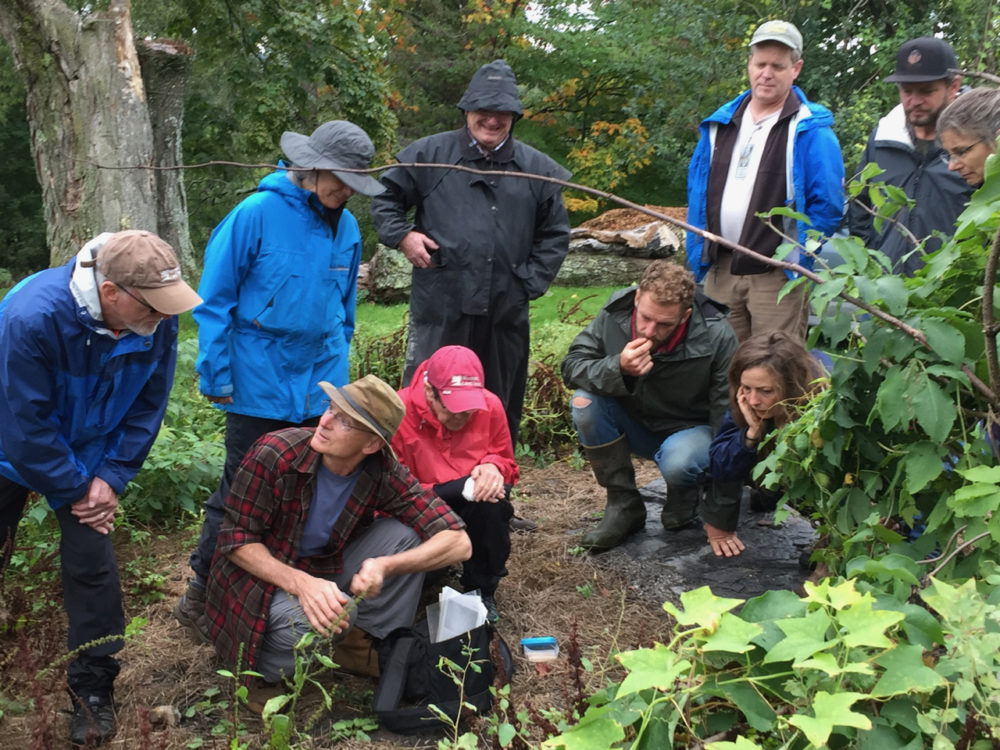
Joyful curiosity. That’s the spirit Mike Kessler embodies as he explores the art of wildlife tracking. Last Friday, 16 of us had the good fortune to dip into Mike’s enthusiasm, experience, insights, and holistic approach in VFF’s latest workshop, Re-storying the Earth Through Wildlife Tracking.

As an animal moves through the forest, he or she leaves traces of those movements, written like stories on the land. Like a single word from a novel, a single track reveals little when separated from the context of the tracks that came before and after. Learning to read those tracks is both art and science–that much is obvious when watching Mike at work in the forest.
During his three-hour introductory tracking workshop at Vermont Family Forests’ Wells Farm in Lincoln last week, Mike assured workshop participants that such skillful reading of the landscape lies within everyone’s grasp–a genetic gift bequeathed by all the generations of humans who came long before us and relied on their tracking wits to eat and to avoid being eaten.
With attentive practice, we gain fluency in the language of wildlife tracking. In time, Mike assured us, the land’s stories can grow from “See Spot Run” to War and Peace!
Skillful tracking, as Mike teaches it, begins with settling in and coming to your senses–all of them. Hunker down. Touch the earth. Get quiet, body and mind. Before exploring tracks in the forests and fields of Wells Farm, Mike had us take a half hour to simply be in the woods, quietly in one place, without agenda or expectations, tuning in to the sights, sounds, smells, and textures of the forest.

He then led us to a few of the many nearby track stories written on the fields and forests of Wells Farm. You don’t need fresh mud or freshly fallen snow to track an animal over the land, Mike assured us. If you waited for those perfect conditions, you’d rarely read the land at all. You don’t even need an in-depth knowledge of the tracks each wildlife species creates.
What you do need is full sensory awareness. You may have seen a track, but have you smelled it? And have you compared that smell to the nearby landscape to notice differences? What does the track feel like beneath your fingertips? Mike showed us, as we leaned eagerly over his shoulders, how he reads track compressions in pine needles and grass.
“A track is a disturbance to a baseline,” he said. Pay attention to what constitutes the undisturbed baseline of the land you’re studying, and you’ll more easily recognize where disturbances lie. A key to that attentiveness to the broader landscape is to allow your vision to be expansive as you take in the scene–engaging your peripheral vision–rather than zeroed in on details, at least at first.
Mike imparted a great deal of knowledge during the workshop, but far more than that, he shared an intense love and consciousness of the land, and a deep respect and curiosity for all who live there. He unabashedly brings love, spirit, and imagination into the realm of science–holistic engagement at its best.

After Mike’s morning of teaching, we gathered by the Mother Earth oven and together made wood-fired pizzas topped with onions, peppers, and herbs from the Wells Farm garden and drank apple cider pressed from the farm’s apple orchard. To our way of thinking at VFF, this was every bit as much of the workshop process as the tracking itself. Celebrating, eating, drinking, and talking together are all integral parts of engaging with this place we call home.
Our intention was to use this brief introductory workshop as a test balloon of sorts, to gauge interest in a more in-depth tracking workshop with Mike this winter. Judging from the workshop’s full enrollment and waiting list, interest is strong, so watch for notices over the next few months about a tracking workshop early next year.





